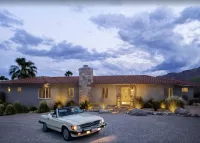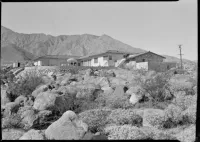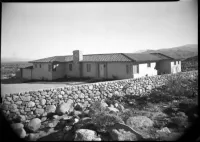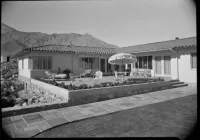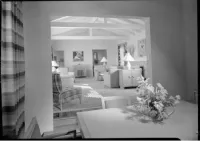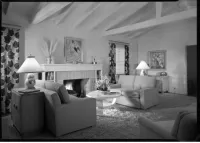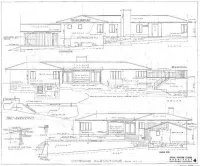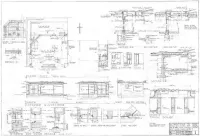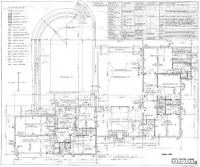Share what you know,
and discover more.
Share what you know,
and discover more.
Dec 21, 2021
Dec 21, 2021
875 West Chino Canyon Road, Palm Springs, CA, USA
Posted Date
Dec 21, 2021
Historical Record Date
Dec 21, 2021
Source Name
VRBO
Delete Story
Are you sure you want to delete this story?
Sep 19, 2016
Sep 19, 2016
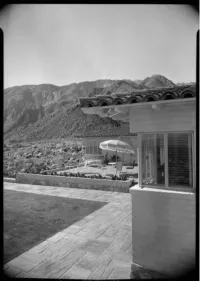
-

- Dave D
National Register of Historic Places - Summary
Summary Hamrick House is a one-story residence designed in the Spanish/Mediterranean Revival style and constructed in 1942. Located in an area of Palm Springs called Little Tuscany Estates, the house was designed by two master architects, John Porter Clark and Albert Frey. Hamrick House is constructed of stone and masonry foundation, plaster and masonry walls, with clay tile roof with exposed eaves of wooden tongue and groove. Prominent design elements consist of a stone chimney, stone pilasters, and a stone wall along the property’s north and west borders, integral to the original design. The five bedroom, five bathroom home retains the steel casement windows and screens, original roof tile, and the concrete adobe brick exterior, painted in neutral tones to blend with the desert sand. Hamrick House retains all aspects of historic integrity including location, design, setting, materials, workmanship, feeling, and association. Narrative Description Setting Little Tuscany Estates consists of custom designed homes of varied vintage and styles. The area features a cluster of other Clark and Frey houses, including a National Register listed Frey house designed for industrial designer Raymond Loewy. Palm Springs locally designated Class One Historic Sites in the neighborhood include Kaufmann House designed by master architect Richard Neutra, Edris House designed by master architect E. Stewart Williams, and Max Palevsky’s house, designed by master architect Craig Ellwood. The 0.67-acre site is an irregularly shaped lot on a ridge with a dramatic view of Palm Springs, the San Jacinto Mountains, and the Coachella Valley. To the north is undeveloped hillside with many large boulders and natural desert vegetation, as it was in 1942. The placement of the home is near the road, with terrace and landscaped areas minimized, allowing the rugged nature of the site to be preserved. The plantings consist of 80-year old palm trees, cactus, and grapefruit trees, and meandering pathways that lead to multiple sitting areas. The house retains its original noninvasive site plan, sensitive to the low hillside lot, built around boulders, and exploiting the views of natural boulders within the surrounding landscape. The front fieldstone wall has dual vehicular gates to secure a gravel semi-circular driveway that leads to the home. Building Hamrick House is a single-family residence designed by architects John Porter Clark and Albert Frey. John and Fannie Hamrick commissioned Clark and Frey as Architect/Builder on April 18, 1941, for their 3,580 square foot vacation home. Clark and Frey’s work is recognized to be of major importance in the development of the desert modernist movement.1 While many of their residential works of this period were comprised of popular revival styles, the designs are quite modern: generous utilization of glass corner casement windows, open floor plan, and flat planar wall surfaces. All are distinctive elements within Hamrick House. The exterior stonework of the house brings it into harmony with the desert environment, and remains one of its most striking features. The clean, simple lines of the desert rock accentuate the concrete and rock foundation, prominent rock chimney, wooden front door, and rock garage wall. The front door incorporates an original hammered metal knocker in the shape of a fleur de lis, and an original etched glass window with desert plant motif above, both designed by Albert Frey. Original steel sash casement windows remain. In the rear of the house, an original upper sundeck remains. The sundeck is located above the garage. The exterior colors of the house reflect the original paint palette of neutral taupe and gray to blend with the natural boulders and surrounding landscape. An original light fixture remains, allegedly to be used to indicate to neighbors that cocktail hour had begun. The single-story house has an L-shaped plan, with a central living room adjacent to the dining room and kitchen, and a garage. The majority of private spaces, bedrooms and bathrooms, are located perpendicular to the main living spaces. The foundation of the house is constructed of concrete and desert rock, and the structural framing is wood. The framing is a combination of post and beam, trusses, and bearing walls. The house consists of double layers of adobe brick horizontal coursing, on all of the exterior and their interior facing walls. Its square-edged archways also have double-thick walls. The original clay-tiled, hip roof has a 5:12 pitch. The living room retains the original exposed wooden tongue and groove ceiling, and responds to the hip roof structure, accentuating the exposed beams, and rafters. The north wall is dominated by an original fireplace with flanking bookshelves. The original tile pattern surrounding the fireplace remains; the material was replaced with white Carrera marble, circa 2006. Many of the original colors, including turquoise, remain on the interior. Original wood floors, wood doors, and hardware remain intact throughout the house. The floor plan circulates as originally designed, utilizing the same spaces and functions, with the exception of the additional guest suite, constructed in the early 1980s. Landscape Features Nearly a dozen palm trees planted in the 1930s flank the north side of the property. Natural boulders of varying shapes and sizes are abundant throughout the landscaping, as are a variety of native cacti. Other landscape features include mature ocotillo, sumac, olive and citrus trees, lantana, oleander, roses, bougainvillea, and a variety of desert landscape grasses. Alterations & Integrity In 1947, to further enjoy the expansive view of the desert at the rear of the house, John and Fannie Hamrick commissioned Clark and Frey to design a sunroom. Located on the property’s south side, the octagonal enclosed sunroom utilized industrial materials for the window frames and roof; an associated style of Frey’s, in later, more renowned projects. The addition reflects the transition of the architects from a traditional style, to a more modern minimalist style. Here, large panes of glass were articulated by thin tubular corner columns and capped by a flat roof plane, thus achieving the modernist concept of blurring the boundaries between interior and exterior space. A glass wall was removed between the living room and the sunroom, to allow for a seamless flow of interior space. The sunroom’s ceiling consists of a grid pattern of beams, squares, and rectangles. These were designed for flexibility of design to add future skylights. Frey’s National Register listed-Tramway Gas Station (1965, listed 2015) shares similar grid patterns in the ceiling. In the early 1980s, an addition was constructed on the east side of the home, consisting of an additional bedroom and bathroom. The roof form of the addition is gabled, unlike the hip roof on the original construction. The addition incorporates materials and design details consistent and sympathetic with the architecture of the original house. The addition responds to the Secretary of the Interiors Standards for Rehabilitation. It does not destroy historic materials that characterize the property. The work has been differentiated from the old and is compatible with the massing, size, scale, and architectural features to protect the historic integrity of the property and its environment. The addition has been undertaken in such a manner that if removed in the future, the essential form and integrity of the historic property and its environment would be unimpaired. A swimming pool was designed by Clark and Frey as part of the original landscape. Due to the onset of World War II, the Hamricks felt that it was in poor taste to indulge in such a luxury. In 2006, a pool was built in the same dimensions and orientation of the original design of 1941. The pool and terrace are sympathetic to the house in location and size, and also respect the original Clark and Frey site plan in its placement at a slightly lower elevation than the floor elevation of the house. The house retains nearly all its original exterior features, elements, and materials, including masonry walls, clay tile roof, and steel sash casement windows. An exception to this is a window in the kitchen which was moved from the corner and relocated four feet west along the south elevation. Another modification to the original house is the interior fireplace. Marble was added to the fireplace façade to respond to the pattern of the original brick that had been removed by a previous owner. In spite of the minor changes that include the kitchen window and the fireplace tile replacement, and the additions designed by the original master architects that include the 1947 Sunroom and the 2006 swimming pool, the building still retains integrity. The major addition of the guest suite in the early 1980s responds to the Secretary of the Interiors Standards, and the property retains integrity of location, design, setting, materials, feeling, workmanship, and association to convey that it is as worthy of recognition as when it was originally designed by Clark and Frey. The house’s location remains the same. The floor plan, integration into the natural landscape, and natural materials of adobe brick, stone, and clay tile reflect its original, simple design. Organic stone patterns remain from 1942. Artisan workmanship of the concrete and stone, adobe bricks, and clay tile remain. The property evokes the sense of past time and place, nestled into the desert landscape perched upon the desert rock with views of the desert floor below.
National Register of Historic Places - Summary
Summary Hamrick House is a one-story residence designed in the Spanish/Mediterranean Revival style and constructed in 1942. Located in an area of Palm Springs called Little Tuscany Estates, the house was designed by two master architects, John Porter Clark and Albert Frey. Hamrick House is constructed of stone and masonry foundation, plaster and masonry walls, with clay tile roof with exposed eaves of wooden tongue and groove. Prominent design elements consist of a stone chimney, stone pilasters, and a stone wall along the property’s north and west borders, integral to the original design. The five bedroom, five bathroom home retains the steel casement windows and screens, original roof tile, and the concrete adobe brick exterior, painted in neutral tones to blend with the desert sand. Hamrick House retains all aspects of historic integrity including location, design, setting, materials, workmanship, feeling, and association. Narrative Description Setting Little Tuscany Estates consists of custom designed homes of varied vintage and styles. The area features a cluster of other Clark and Frey houses, including a National Register listed Frey house designed for industrial designer Raymond Loewy. Palm Springs locally designated Class One Historic Sites in the neighborhood include Kaufmann House designed by master architect Richard Neutra, Edris House designed by master architect E. Stewart Williams, and Max Palevsky’s house, designed by master architect Craig Ellwood. The 0.67-acre site is an irregularly shaped lot on a ridge with a dramatic view of Palm Springs, the San Jacinto Mountains, and the Coachella Valley. To the north is undeveloped hillside with many large boulders and natural desert vegetation, as it was in 1942. The placement of the home is near the road, with terrace and landscaped areas minimized, allowing the rugged nature of the site to be preserved. The plantings consist of 80-year old palm trees, cactus, and grapefruit trees, and meandering pathways that lead to multiple sitting areas. The house retains its original noninvasive site plan, sensitive to the low hillside lot, built around boulders, and exploiting the views of natural boulders within the surrounding landscape. The front fieldstone wall has dual vehicular gates to secure a gravel semi-circular driveway that leads to the home. Building Hamrick House is a single-family residence designed by architects John Porter Clark and Albert Frey. John and Fannie Hamrick commissioned Clark and Frey as Architect/Builder on April 18, 1941, for their 3,580 square foot vacation home. Clark and Frey’s work is recognized to be of major importance in the development of the desert modernist movement.1 While many of their residential works of this period were comprised of popular revival styles, the designs are quite modern: generous utilization of glass corner casement windows, open floor plan, and flat planar wall surfaces. All are distinctive elements within Hamrick House. The exterior stonework of the house brings it into harmony with the desert environment, and remains one of its most striking features. The clean, simple lines of the desert rock accentuate the concrete and rock foundation, prominent rock chimney, wooden front door, and rock garage wall. The front door incorporates an original hammered metal knocker in the shape of a fleur de lis, and an original etched glass window with desert plant motif above, both designed by Albert Frey. Original steel sash casement windows remain. In the rear of the house, an original upper sundeck remains. The sundeck is located above the garage. The exterior colors of the house reflect the original paint palette of neutral taupe and gray to blend with the natural boulders and surrounding landscape. An original light fixture remains, allegedly to be used to indicate to neighbors that cocktail hour had begun. The single-story house has an L-shaped plan, with a central living room adjacent to the dining room and kitchen, and a garage. The majority of private spaces, bedrooms and bathrooms, are located perpendicular to the main living spaces. The foundation of the house is constructed of concrete and desert rock, and the structural framing is wood. The framing is a combination of post and beam, trusses, and bearing walls. The house consists of double layers of adobe brick horizontal coursing, on all of the exterior and their interior facing walls. Its square-edged archways also have double-thick walls. The original clay-tiled, hip roof has a 5:12 pitch. The living room retains the original exposed wooden tongue and groove ceiling, and responds to the hip roof structure, accentuating the exposed beams, and rafters. The north wall is dominated by an original fireplace with flanking bookshelves. The original tile pattern surrounding the fireplace remains; the material was replaced with white Carrera marble, circa 2006. Many of the original colors, including turquoise, remain on the interior. Original wood floors, wood doors, and hardware remain intact throughout the house. The floor plan circulates as originally designed, utilizing the same spaces and functions, with the exception of the additional guest suite, constructed in the early 1980s. Landscape Features Nearly a dozen palm trees planted in the 1930s flank the north side of the property. Natural boulders of varying shapes and sizes are abundant throughout the landscaping, as are a variety of native cacti. Other landscape features include mature ocotillo, sumac, olive and citrus trees, lantana, oleander, roses, bougainvillea, and a variety of desert landscape grasses. Alterations & Integrity In 1947, to further enjoy the expansive view of the desert at the rear of the house, John and Fannie Hamrick commissioned Clark and Frey to design a sunroom. Located on the property’s south side, the octagonal enclosed sunroom utilized industrial materials for the window frames and roof; an associated style of Frey’s, in later, more renowned projects. The addition reflects the transition of the architects from a traditional style, to a more modern minimalist style. Here, large panes of glass were articulated by thin tubular corner columns and capped by a flat roof plane, thus achieving the modernist concept of blurring the boundaries between interior and exterior space. A glass wall was removed between the living room and the sunroom, to allow for a seamless flow of interior space. The sunroom’s ceiling consists of a grid pattern of beams, squares, and rectangles. These were designed for flexibility of design to add future skylights. Frey’s National Register listed-Tramway Gas Station (1965, listed 2015) shares similar grid patterns in the ceiling. In the early 1980s, an addition was constructed on the east side of the home, consisting of an additional bedroom and bathroom. The roof form of the addition is gabled, unlike the hip roof on the original construction. The addition incorporates materials and design details consistent and sympathetic with the architecture of the original house. The addition responds to the Secretary of the Interiors Standards for Rehabilitation. It does not destroy historic materials that characterize the property. The work has been differentiated from the old and is compatible with the massing, size, scale, and architectural features to protect the historic integrity of the property and its environment. The addition has been undertaken in such a manner that if removed in the future, the essential form and integrity of the historic property and its environment would be unimpaired. A swimming pool was designed by Clark and Frey as part of the original landscape. Due to the onset of World War II, the Hamricks felt that it was in poor taste to indulge in such a luxury. In 2006, a pool was built in the same dimensions and orientation of the original design of 1941. The pool and terrace are sympathetic to the house in location and size, and also respect the original Clark and Frey site plan in its placement at a slightly lower elevation than the floor elevation of the house. The house retains nearly all its original exterior features, elements, and materials, including masonry walls, clay tile roof, and steel sash casement windows. An exception to this is a window in the kitchen which was moved from the corner and relocated four feet west along the south elevation. Another modification to the original house is the interior fireplace. Marble was added to the fireplace façade to respond to the pattern of the original brick that had been removed by a previous owner. In spite of the minor changes that include the kitchen window and the fireplace tile replacement, and the additions designed by the original master architects that include the 1947 Sunroom and the 2006 swimming pool, the building still retains integrity. The major addition of the guest suite in the early 1980s responds to the Secretary of the Interiors Standards, and the property retains integrity of location, design, setting, materials, feeling, workmanship, and association to convey that it is as worthy of recognition as when it was originally designed by Clark and Frey. The house’s location remains the same. The floor plan, integration into the natural landscape, and natural materials of adobe brick, stone, and clay tile reflect its original, simple design. Organic stone patterns remain from 1942. Artisan workmanship of the concrete and stone, adobe bricks, and clay tile remain. The property evokes the sense of past time and place, nestled into the desert landscape perched upon the desert rock with views of the desert floor below.
National Register of Historic Places - Summary
SummaryHamrick House is a one-story residence designed in the Spanish/Mediterranean Revival style and constructed in 1942. Located in an area of Palm Springs called Little Tuscany Estates, the house was designed by two master architects, John Porter Clark and Albert Frey. Hamrick House is constructed of stone and masonry foundation, plaster and masonry walls, with clay tile roof with exposed eaves of wooden tongue and groove. Prominent design elements consist of a stone chimney, stone pilasters, and a stone wall along the property’s north and west borders, integral to the original design. The five bedroom, five bathroom home retains the steel casement windows and screens, original roof tile, and the concrete adobe brick exterior, painted in neutral tones to blend with the desert sand. Hamrick House retains all aspects of historic integrity including location, design, setting, materials, workmanship, feeling, and association.
Narrative Description
Setting
Little Tuscany Estates consists of custom designed homes of varied vintage and styles. The area features a cluster of other Clark and Frey houses, including a National Register listed Frey house designed for industrial designer Raymond Loewy. Palm Springs locally designated Class One Historic Sites in the neighborhood include Kaufmann House designed by master architect Richard Neutra, Edris House designed by master architect E. Stewart Williams, and Max Palevsky’s house, designed by master architect Craig Ellwood. The 0.67-acre site is an irregularly shaped lot on a ridge with a dramatic view of Palm Springs, the San Jacinto Mountains, and the Coachella Valley. To the north is undeveloped hillside with many large boulders and natural desert vegetation, as it was in 1942. The placement of the home is near the road, with terrace and landscaped areas minimized, allowing the rugged nature of the site to be preserved. The plantings consist of 80-year old palm trees, cactus, and grapefruit trees, and meandering pathways that lead to multiple sitting areas. The house retains its original noninvasive site plan, sensitive to the low hillside lot, built around boulders, and exploiting the views of natural boulders within the surrounding landscape. The front fieldstone wall has dual vehicular gates to secure a gravel semi-circular driveway that leads to the home.
Building
Hamrick House is a single-family residence designed by architects John Porter Clark and Albert Frey. John and Fannie Hamrick commissioned Clark and Frey as Architect/Builder on April 18, 1941, for their 3,580 square foot vacation home. Clark and Frey’s work is recognized to be of major importance in the development of the desert modernist movement.1 While many of their residential works of this period were comprised of popular revival styles, the designs are quite modern: generous utilization of glass corner casement windows, open floor plan, and flat planar wall surfaces. All are distinctive elements within Hamrick House.
The exterior stonework of the house brings it into harmony with the desert environment, and remains one of its most striking features. The clean, simple lines of the desert rock accentuate the concrete and rock foundation, prominent rock chimney, wooden front door, and rock garage wall. The front door incorporates an original hammered metal knocker in the shape of a fleur de lis, and an original etched glass window with desert plant motif above, both designed by Albert Frey. Original steel sash casement windows remain. In the rear of the house, an original upper sundeck remains. The sundeck is located above the garage. The exterior colors of the house reflect the original paint palette of neutral taupe and gray to blend with the natural boulders and surrounding landscape. An original light fixture remains, allegedly to be used to indicate to neighbors that cocktail hour had begun.
The single-story house has an L-shaped plan, with a central living room adjacent to the dining room and kitchen, and a garage. The majority of private spaces, bedrooms and bathrooms, are located perpendicular to the main living spaces. The foundation of the house is constructed of concrete and desert rock, and the structural framing is wood. The framing is a combination of post and beam, trusses, and bearing walls. The house consists of double layers of adobe brick horizontal coursing, on all of the exterior and their interior facing walls. Its square-edged archways also have double-thick walls. The original clay-tiled, hip roof has a 5:12 pitch.
The living room retains the original exposed wooden tongue and groove ceiling, and responds to the hip roof structure, accentuating the exposed beams, and rafters. The north wall is dominated by an original fireplace with flanking bookshelves. The original tile pattern surrounding the fireplace remains; the material was replaced with white Carrera marble, circa 2006. Many of the original colors, including turquoise, remain on the interior. Original wood floors, wood doors, and hardware remain intact throughout the house. The floor plan circulates as originally designed, utilizing the same spaces and functions, with the exception of the additional guest suite, constructed in the early 1980s.
Landscape Features
Nearly a dozen palm trees planted in the 1930s flank the north side of the property. Natural boulders of varying shapes and sizes are abundant throughout the landscaping, as are a variety of native cacti. Other landscape features include mature ocotillo, sumac, olive and citrus trees, lantana, oleander, roses, bougainvillea, and a variety of desert landscape grasses.
Alterations & Integrity
In 1947, to further enjoy the expansive view of the desert at the rear of the house, John and Fannie Hamrick commissioned Clark and Frey to design a sunroom. Located on the property’s south side, the octagonal enclosed sunroom utilized industrial materials for the window frames and roof; an associated style of Frey’s, in later, more renowned projects. The addition reflects the transition of the architects from a traditional style, to a more modern minimalist style. Here, large panes of glass were articulated by thin tubular corner columns and capped by a flat roof plane, thus achieving the modernist concept of blurring the boundaries between interior and exterior space. A glass wall was removed between the living room and the sunroom, to allow for a seamless flow of interior space. The sunroom’s ceiling consists of a grid pattern of beams, squares, and rectangles. These were designed for flexibility of design to add future skylights. Frey’s National Register listed-Tramway Gas Station (1965, listed 2015) shares similar grid patterns in the ceiling.
In the early 1980s, an addition was constructed on the east side of the home, consisting of an additional bedroom and bathroom. The roof form of the addition is gabled, unlike the hip roof on the original construction. The addition incorporates materials and design details consistent and sympathetic with the architecture of the original house. The addition responds to the Secretary of the Interiors Standards for Rehabilitation. It does not destroy historic materials that characterize the property. The work has been differentiated from the old and is compatible with the massing, size, scale, and architectural features to protect the historic integrity of the property and its environment. The addition has been undertaken in such a manner that if removed in the future, the essential form and integrity of the historic property and its environment would be unimpaired.
A swimming pool was designed by Clark and Frey as part of the original landscape. Due to the onset of World War II, the Hamricks felt that it was in poor taste to indulge in such a luxury. In 2006, a pool was built in the same dimensions and orientation of the original design of 1941. The pool and terrace are sympathetic to the house in location and size, and also respect the original Clark and Frey site plan in its placement at a slightly lower elevation than the floor elevation of the house.
The house retains nearly all its original exterior features, elements, and materials, including masonry walls, clay tile roof, and steel sash casement windows. An exception to this is a window in the kitchen which was moved from the corner and relocated four feet west along the south elevation. Another modification to the original house is the interior fireplace. Marble was added to the fireplace façade to respond to the pattern of the original brick that had been removed by a previous owner.
In spite of the minor changes that include the kitchen window and the fireplace tile replacement, and the additions designed by the original master architects that include the 1947 Sunroom and the 2006 swimming pool, the building still retains integrity. The major addition of the guest suite in the early 1980s responds to the Secretary of the Interiors Standards, and the property retains integrity of location, design, setting, materials, feeling, workmanship, and association to convey that it is as worthy of recognition as when it was originally designed by Clark and Frey.
The house’s location remains the same. The floor plan, integration into the natural landscape, and natural materials of adobe brick, stone, and clay tile reflect its original, simple design. Organic stone patterns remain from 1942. Artisan workmanship of the concrete and stone, adobe bricks, and clay tile remain. The property evokes the sense of past time and place, nestled into the desert landscape perched upon the desert rock with views of the desert floor below.
Posted Date
Dec 21, 2021
Historical Record Date
Sep 19, 2016
Source Name
United States Department of the Interior - National Park Service
Delete Story
Are you sure you want to delete this story?


